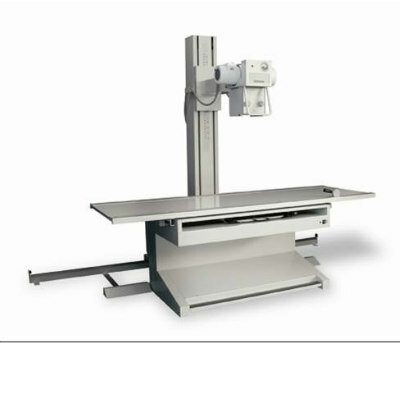New Generation of X-Ray Detectors Driving Growth of Global Medical X-Ray Detectors Market
|
By MedImaging International staff writers Posted on 18 Jun 2021 |

Illustration
The global medical X-ray detectors market was valued at USD 2.95 billion in 2020 and is projected to grow at a CAGR of 5.1% during the forecast period from 2021 to 2029, driven mainly by the new generation of X-ray detectors.
These are the latest findings of ResearchAndMarkets.com (Dublin, Ireland), a market research store.
The new generation of X-ray detectors equipped with large-area, flat-panel detectors with a combination of thin-film transistor are eligible for providing rapid access to digital images. Thus, such rapid technological evolution of digital radiography is expected to increase access among radiologists to abundant information on an extensive variety of large-area, and flat-panel electronic detectors. Researchers from the US China and Netherlands built highly sensitive X-ray detectors in 2016. This technology helps detectors to take X-ray images using reduced doses of ionizing radiation, thus leading to lower cancer risk among patients.
This innovation has forced many key players to develop extremely sensitive X-ray detectors that will reduce the radiation dose. X-ray photon energy is a vital part of X-ray detectors as X-ray absorption coefficients of the various elements of the system are majorly dependent on it. Thus, precisely developed X-ray photon energy with the novel technology would increase penetration capabilities. With the help of this technology, the complete scheme of source, object and detector could be reviewed in the near future, and enhance the spectrum and detector specifically to the nature and composition of the target under investigation.
In 2020, the flat panel X-ray detectors segment held the highest share of the global medical X-ray detectors market due to their high sensitivity, greater speed than other X-ray detectors, reduced image distortion as compared to X-ray image intensifiers, increasing prevalence of chronic diseases, and greater awareness of early disease diagnosis. However, the computed radiography (CR) detectors segment is expected to record the fastest growth during the forecast period due to increasing adoption of X-ray technology, and rising penetration of the latest technologies in the developing and underdeveloped countries.
Geographically, North America was the world’s largest market for medical X-ray detectors in 2020 due to the increasing prevalence of chronic diseases & injuries, developed diagnostic infrastructure, continued developments in the field of X-ray detectors technology, and early adoption of the latest technologies in the region. However, Asia Pacific is expected to be the world’s fastest growing market for medical X-ray detectors during the forecast period due to the rising population in India and China, developing healthcare infrastructure and skilled healthcare professionals that will aid the overall growth of the treatment & diagnostic devices market of this region. Additionally, increasing industrialization in Asia Pacific expected to enhance the overall growth of the medical X-ray detectors market by making the technology more accessible to the untapped markets in the region.
Related Links:
ResearchAndMarkets.com
These are the latest findings of ResearchAndMarkets.com (Dublin, Ireland), a market research store.
The new generation of X-ray detectors equipped with large-area, flat-panel detectors with a combination of thin-film transistor are eligible for providing rapid access to digital images. Thus, such rapid technological evolution of digital radiography is expected to increase access among radiologists to abundant information on an extensive variety of large-area, and flat-panel electronic detectors. Researchers from the US China and Netherlands built highly sensitive X-ray detectors in 2016. This technology helps detectors to take X-ray images using reduced doses of ionizing radiation, thus leading to lower cancer risk among patients.
This innovation has forced many key players to develop extremely sensitive X-ray detectors that will reduce the radiation dose. X-ray photon energy is a vital part of X-ray detectors as X-ray absorption coefficients of the various elements of the system are majorly dependent on it. Thus, precisely developed X-ray photon energy with the novel technology would increase penetration capabilities. With the help of this technology, the complete scheme of source, object and detector could be reviewed in the near future, and enhance the spectrum and detector specifically to the nature and composition of the target under investigation.
In 2020, the flat panel X-ray detectors segment held the highest share of the global medical X-ray detectors market due to their high sensitivity, greater speed than other X-ray detectors, reduced image distortion as compared to X-ray image intensifiers, increasing prevalence of chronic diseases, and greater awareness of early disease diagnosis. However, the computed radiography (CR) detectors segment is expected to record the fastest growth during the forecast period due to increasing adoption of X-ray technology, and rising penetration of the latest technologies in the developing and underdeveloped countries.
Geographically, North America was the world’s largest market for medical X-ray detectors in 2020 due to the increasing prevalence of chronic diseases & injuries, developed diagnostic infrastructure, continued developments in the field of X-ray detectors technology, and early adoption of the latest technologies in the region. However, Asia Pacific is expected to be the world’s fastest growing market for medical X-ray detectors during the forecast period due to the rising population in India and China, developing healthcare infrastructure and skilled healthcare professionals that will aid the overall growth of the treatment & diagnostic devices market of this region. Additionally, increasing industrialization in Asia Pacific expected to enhance the overall growth of the medical X-ray detectors market by making the technology more accessible to the untapped markets in the region.
Related Links:
ResearchAndMarkets.com
Latest Industry News News
- Bayer and Google Partner on New AI Product for Radiologists
- Samsung and Bracco Enter Into New Diagnostic Ultrasound Technology Agreement
- IBA Acquires Radcal to Expand Medical Imaging Quality Assurance Offering
- International Societies Suggest Key Considerations for AI Radiology Tools
- Samsung's X-Ray Devices to Be Powered by Lunit AI Solutions for Advanced Chest Screening
- Canon Medical and Olympus Collaborate on Endoscopic Ultrasound Systems
- GE HealthCare Acquires AI Imaging Analysis Company MIM Software
- First Ever International Criteria Lays Foundation for Improved Diagnostic Imaging of Brain Tumors
- RSNA Unveils 10 Most Cited Radiology Studies of 2023
- RSNA 2023 Technical Exhibits to Offer Innovations in AI, 3D Printing and More
- AI Medical Imaging Products to Increase Five-Fold by 2035, Finds Study
- RSNA 2023 Technical Exhibits to Highlight Latest Medical Imaging Innovations
- AI-Powered Technologies to Aid Interpretation of X-Ray and MRI Images for Improved Disease Diagnosis
- Hologic and Bayer Partner to Improve Mammography Imaging
- Global Fixed and Mobile C-Arms Market Driven by Increasing Surgical Procedures
- Global Contrast Enhanced Ultrasound Market Driven by Demand for Early Detection of Chronic Diseases
Channels
Radiography
view channel
Novel Breast Imaging System Proves As Effective As Mammography
Breast cancer remains the most frequently diagnosed cancer among women. It is projected that one in eight women will be diagnosed with breast cancer during her lifetime, and one in 42 women who turn 50... Read more
AI Assistance Improves Breast-Cancer Screening by Reducing False Positives
Radiologists typically detect one case of cancer for every 200 mammograms reviewed. However, these evaluations often result in false positives, leading to unnecessary patient recalls for additional testing,... Read moreMRI
view channel
PET/MRI Improves Diagnostic Accuracy for Prostate Cancer Patients
The Prostate Imaging Reporting and Data System (PI-RADS) is a five-point scale to assess potential prostate cancer in MR images. PI-RADS category 3 which offers an unclear suggestion of clinically significant... Read more
Next Generation MR-Guided Focused Ultrasound Ushers In Future of Incisionless Neurosurgery
Essential tremor, often called familial, idiopathic, or benign tremor, leads to uncontrollable shaking that significantly affects a person’s life. When traditional medications do not alleviate symptoms,... Read more
Two-Part MRI Scan Detects Prostate Cancer More Quickly without Compromising Diagnostic Quality
Prostate cancer ranks as the most prevalent cancer among men. Over the last decade, the introduction of MRI scans has significantly transformed the diagnosis process, marking the most substantial advancement... Read moreUltrasound
view channel
Deep Learning Advances Super-Resolution Ultrasound Imaging
Ultrasound localization microscopy (ULM) is an advanced imaging technique that offers high-resolution visualization of microvascular structures. It employs microbubbles, FDA-approved contrast agents, injected... Read more
Novel Ultrasound-Launched Targeted Nanoparticle Eliminates Biofilm and Bacterial Infection
Biofilms, formed by bacteria aggregating into dense communities for protection against harsh environmental conditions, are a significant contributor to various infectious diseases. Biofilms frequently... Read moreNuclear Medicine
view channel
New SPECT/CT Technique Could Change Imaging Practices and Increase Patient Access
The development of lead-212 (212Pb)-PSMA–based targeted alpha therapy (TAT) is garnering significant interest in treating patients with metastatic castration-resistant prostate cancer. The imaging of 212Pb,... Read moreNew Radiotheranostic System Detects and Treats Ovarian Cancer Noninvasively
Ovarian cancer is the most lethal gynecological cancer, with less than a 30% five-year survival rate for those diagnosed in late stages. Despite surgery and platinum-based chemotherapy being the standard... Read more
AI System Automatically and Reliably Detects Cardiac Amyloidosis Using Scintigraphy Imaging
Cardiac amyloidosis, a condition characterized by the buildup of abnormal protein deposits (amyloids) in the heart muscle, severely affects heart function and can lead to heart failure or death without... Read moreGeneral/Advanced Imaging
view channel
New AI Method Captures Uncertainty in Medical Images
In the field of biomedicine, segmentation is the process of annotating pixels from an important structure in medical images, such as organs or cells. Artificial Intelligence (AI) models are utilized to... Read more.jpg)
CT Coronary Angiography Reduces Need for Invasive Tests to Diagnose Coronary Artery Disease
Coronary artery disease (CAD), one of the leading causes of death worldwide, involves the narrowing of coronary arteries due to atherosclerosis, resulting in insufficient blood flow to the heart muscle.... Read more
Novel Blood Test Could Reduce Need for PET Imaging of Patients with Alzheimer’s
Alzheimer's disease (AD), a condition marked by cognitive decline and the presence of beta-amyloid (Aβ) plaques and neurofibrillary tangles in the brain, poses diagnostic challenges. Amyloid positron emission... Read more.jpg)
CT-Based Deep Learning Algorithm Accurately Differentiates Benign From Malignant Vertebral Fractures
The rise in the aging population is expected to result in a corresponding increase in the prevalence of vertebral fractures which can cause back pain or neurologic compromise, leading to impaired function... Read moreImaging IT
view channel
New Google Cloud Medical Imaging Suite Makes Imaging Healthcare Data More Accessible
Medical imaging is a critical tool used to diagnose patients, and there are billions of medical images scanned globally each year. Imaging data accounts for about 90% of all healthcare data1 and, until... Read more



















